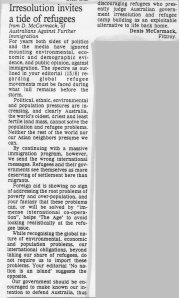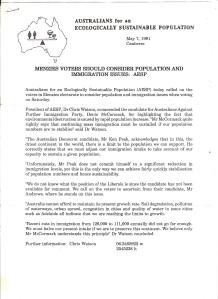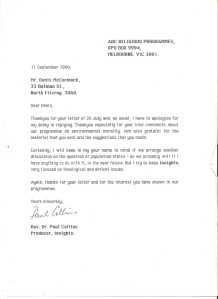Here is a fascinatingly forthright article from 1990 by Tony Abbott, the same man who currently hopes to become Australia’s next Prime Minister. His official statements now about immigration and especially Multiculturalism are sadly changed. Which is the real Abbott? We believe that he nailed the “real issue” back in 1990, and are therefore pleased to share this historical text with our readers.
The real issue is the changing face of our society
By Tony Abbott
Originally published in The Australian, 31 May 1990, page 8.
Immigration risks a backlash because in some suburbs of Sydney and Melbourne it is hard to hear an Australian accent. Of course parts of Australia’s big cities have been immigrant ghettos for a generation. The change is that today’s immigrants look as well as sound different from most Australians.
Yet in 1984 when Professor Geoffrey Blainey first said that Asian immigration posed a challenge to social harmony students picketed his lectures, academic colleagues attacked his previous work and The Sydney Morning Herald editorialised that he had come close to espousing the ‘dangerous canard’ that Australia was being Asianised.
When the Opposition sought to make an issue of Blainey’s comments, the Prime Minister Mr Hawke, accused it of ‘dragging something up out of the gutter of racism’.
In 1988 when the then Opposition leader John Howard conceded a case for slowing down Asian immigration the Prime Minister called on him to retract his ‘inflammatory’, ‘discriminatory’, ‘morally repugnant’ and ‘economically insane’ comments.
When the next Opposition leader, Mr Andrew Peacock opposed the multifunction polis, the Treasurer, Mr Keating, said he had insulted the Japanese.
Whether our political and ‘ethnic’ leaders like it or not, Australia has an immigration debate. It may not happen in Parliament but it is taking place in the pubs, clubs, cafes and dining rooms of Australia, wherever people meet and talk about the future of our country. The issue is not whether migrants help or hinder our economic prospects. That debate is inconclusive, depends on econometric forecasting only experts understand and is only marginally relevant.
The issue is the sort of Australia we want our children and grandchildren to inherit. Will it be a relatively cohesive society that studies Shakespeare, follows cricket, and honours the Anzacs? or will it be a pastiche of cultures with only a geographic home in common?
The Government may think that race and culture do not matter. Anyone who has watched a National League soccer match or walked through inner city Redfern on a Saturday night knows otherwise. Recently, sensitivities over race have led to a proposed ban on interracial adoptions in Western Australia, an attempt to keep foreign flags out of soccer games and the alleged suppression of a report on Vietnamese crime levels.
The pressure of trying to manage immigration policy – recently described by Senator Peter Walsh as a result of a series of lobby-driven cave-ins and blow-outs – has meant six immigration ministers in seven years and the recent sacking of the departmental head.
Yet the Government tries to pretend that immigration and consequent social policy is not a contentious matter. Or that if it is it ought not be frankly discussed.
Race matters – but only because it usually signifies different values, attitudes and beliefs.
The real problem is not race, but culture. Difference does not guarantee trouble – but it makes it much more likely. The trouble with present government policy is that it seems to stress what divides our society rather than what unites it.
As the Government puts it, Multiculturalism means respecting migrant’s rights to maintain their old culture. But if so, and it is just a fancy word for ordinary tolerance, why the need for a special government policy plus specific agencies and a huge propaganda effort to support it?
Supporters insist that it does not mean, for instance Melbourne Greek organisations backing Athens rather than their hometown for the 1996 Olympics. But if it only means respecting migrants as people, why not drop the policy and keep the practice?
Multiculturalism acknowledges culture’s tenacious hold even on people who want to start a new life. But it ignores culture’s presumably even greater grip on people happy to stay where they are. It generously accommodates the cultural yearnings of Greeks, Italians, Vietnamese and other cultural groups living in Australia. But it assumes that stay-put Australians, by contrast, are entirely indifferent to revisions of our history, way of life and national eccentricities.
The Prime Minister often says that Australian life has been enriched by immigrants of diverse race, religion and culture. This pays proper tribute to post war migrant’s contribution, but tacitly denigrates pre-existing Australia. Pre-1950 Australia indeed is often considered a pallid reflection of the British Isles and the opponents of multiculturalism are reckoned to harbour ethnic yearnings of their own.
The difference between someone concerned with the rights and wrongs of British policy in Ireland and someone passionate about the antipathies of Serbs and Croats is that the former has profoundly influenced Australian history and attitudes but the latter has not. Whether one’s own ethnic background is Anglo-Celt, Serbo-Croat, or Vietnamese, to be an Australian means to inherit an Anglo-Celt cultural perspective.
For a Pakistani, becoming an Australian does not mean barracking for Australia against Pakistan in subsequent cricket matches. But it does mean taking an interest in cricket and the other cultural paraphernalia that make Australians different. For an Australian, by contrast, nationality does not mean unswerving devotion to everything in our past. But it does mean appreciation of and respect for that which made us what we are.
Australia has a unique culture – hard to define, like all cultures – but different. We participate in the broader English speaking culture. Yet we have given it our own gloss. Unlike the English, we lack a class perspective: unlike the New Zealanders, we have largely overcome cultural cringe; and unlike the Americans, we possess a sense of humour.
The adherents of Multiculturalism veer between asserting that Australia has no significant culture on the one hand, and that it has a racist and oppressive culture on the other. In fact, one of the finest features of modern Australian culture has been its open-hearted welcome to others who wish to share our way of life.
Australian attitudes have come a long way since Billy Hughes declared, while debating the Immigration Restriction Bill of 1901, that he opposed Asian immigration ‘because of their vices and of their immorality and because of a hundred things that we can only hint at.’
Even then however, in declaring that the Japanese should be excluded for their virtues as much as their vices, another one-time Prime Minister, Alfred Deakin, struck a more liberal note. ‘Our civilization belongs to us and we belong to it.’ he said. ‘We are bred in it and it is bred in us (The Japanese) have their own independent development, their own qualities and their civilization, form of life and government which naturally attaches to them. They are separated from us by a gulf which we cannot bridge to the advantage of either.’
The Japanese Government protested to what quickly became known as the White Australia policy: yet a few years ago in an unguarded moment, the then Japanese prime minister Mr Yasuhiro Nakasone attributed Japan’s economic superiority to racial and cultural purity.
In 1956, the government began to relax restrictions on Asian immigration by allowing the spouses of Australian citizens to settle permanently. Ten years later, the government announced that non-Europeans would be allowed to settle but that numbers would be ‘controlled by a careful assessment of the individual’s qualifications and the basic aim of preserving a homogeneous population’.
In 1971, the government declared that future immigration policy would avoid discrimination on any grounds of race, colour or creed.
Public opinion broadly kept pace with these changes.
But a poll last month shows that 65 per cent now want fewer immigrants. What has happened is that Asian immigration has risen from about 10 to nearly 50 per cent of the total.
Before 1950, Australia’s population was remarkably homogeneous with well over 90 per cent ethnically derived from the British Isles. The post war migration of almost 5 million people means that only about 75 per cent are now British derived, even though about 40 per cent of the post war influx came from Britain and Ireland.
Projecting the present numbers and proportions into the future, demographer Dr Charles Price estimates that Australia will be 20 per cent Asian in 40 years. University of New South Wales political scientist James Mackie reckons that Australia will be about 10 per cent Asian within about 15 years.
Even in a colour-blind world, this would matter. In a world where colour and physiognomy differences often denote cultural differences too, a multi-racial society (at least under policies that encourage migrants to keep their identity) means a much changed society.
In an extensive study of community attitudes to immigration prepared for the Fitzgerald Committee, author Dr Murray Goot notes clear community ambivalence over questions of language and culture. In various surveys, no more than half have endorsed non-discrimination in immigration policy, although large majorities say that ‘migrants are OK as individuals’.
[old photocopy indistinct here] … for instance, 81 per cent agreed that immigrants should try a lot harder to be absorbed into the Australian way of life but, in an apparent contradiction 66 per cent felt that they should be allowed to fit in at their own pace.
Popular ambivalence is not surprising because it is also evident in official pronouncements.
Affirmation of the non-discrimination principle always has the rider that the migrant intake should not jeopardize social harmony. Yet tailoring immigration to community attitudes inevitably involves discriminatory selection.
The contradiction at the heart of present policy – between social harmony and a non-discriminatory immigration selection – can be reconciled but only if newcomers are expected and encouraged to assimilate quickly.
Once, immigration was Australia’s favour to war-shattered countries and a means to secure Australia’s way of life. It played to Australian’s pride in their country. Now, immigration is supposed to give us the culture and brains we lack.
There is no reason why a Vietnamese cannot become thoroughly Australian – providing he is encouraged to do so – rather than remain a Vietnamese who happens to be living here.
The problem with multiculturalism is that Australians whose cultural roots are here feel like an endangered species through destruction of habitat.
The argument is not over which national groups have made better migrants in the past. It is over the type of immigrant who is likely to ensure that Australia remains a happy society for all her existing citizens far into the future. The argument is not whether Australian culture is superior or inferior to others. It’s just that one is ours and others are not.
Let the real debate begin.
———————————————–
Click here to read a 2010 draft essay (as a PDF document) by Denis McCormack which includes the above Abbott article.
To download PDF files, you need to install Acrobat Reader on your computer.


